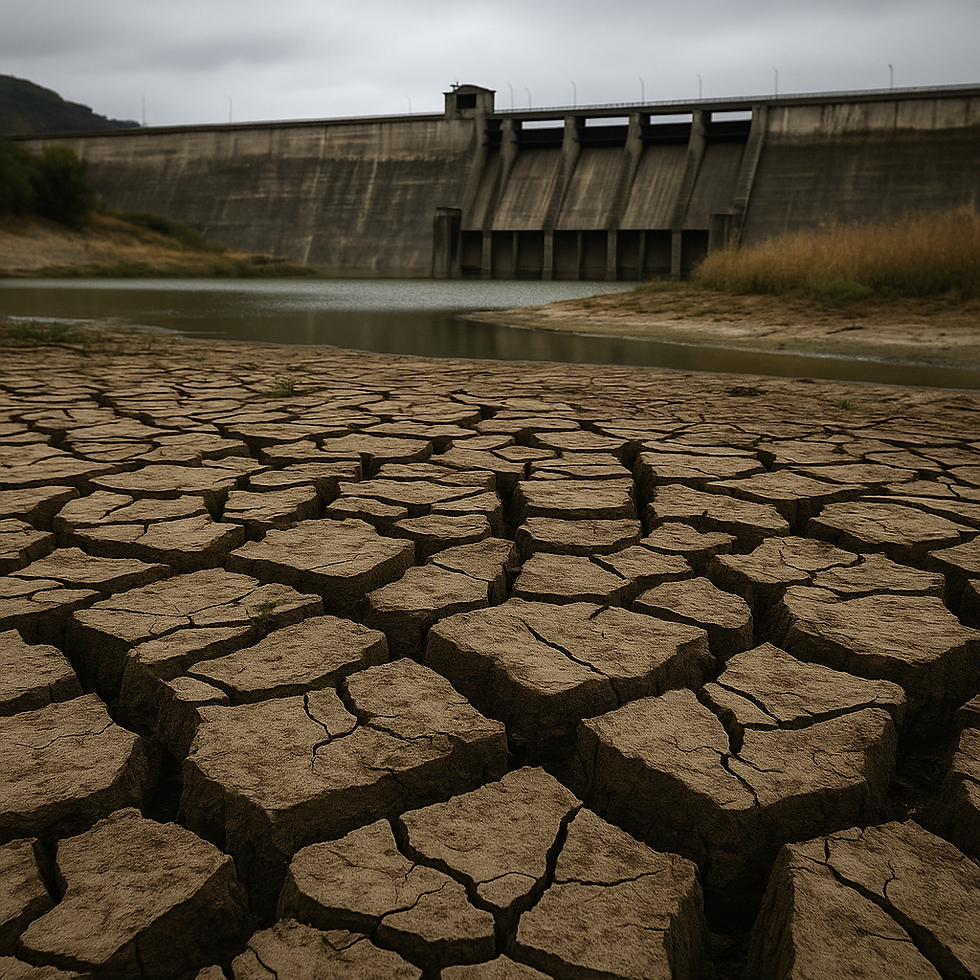Water Mafia: Driver of Environmental Destruction and Immune from Accountability
- Nikahang Kowsar

- Jun 6
- 7 min read
Nik Kowsar and Roozbeh Eskandari

A few weeks ago, Donald Trump’s speech in Riyadh—widely seen as an attempt to attract investors and forge regional alliances—contained an unexpected message for Iranians: a blunt reference to Iran’s water crisis and the use of a term long censored in domestic media and deliberately avoided even by many Persian-language outlets abroad: “Water Mafia.”
Though the phrase came from a controversial figure, it marked the first time Iran’s deep structural corruption in water governance was spotlighted on the international stage.
Whether through political instinct or intelligence briefings, Trump inadvertently exposed a long-hidden alliance: a network of government bodies, military organizations, contractors, profit-driven consultants, and complicit media outlets that have turned water from a resource for sustainable development into a tool for power, rent-seeking, and systemic corruption.
For many Iranians, this was not shocking—but long-overdue validation of stifled truths ignored inside the country for years.
The nervous reaction of some Ministry of Energy officials, consultants, and contractors on private WhatsApp groups and social media wasn’t denial—it was fear that what they had worked so hard to hide had now been dragged into the light.
Water Mafia: A Hidden, Destructive, and Transnational Power
The Water Mafia is no formal institution; it is a complex network of government, military, parliamentary, judicial, economic, and media actors who exploit power to turn water into an instrument of influence, corruption, and control. Shielded from accountability, this network fuels environmental destruction and human rights violations.
Beyond promoting large dam and water transfer projects without proper environmental oversight, this network censors the true scale of Iran’s water crisis through data manipulation and narrative control. Billions of dollars in public funds have been funneled into ecologically disastrous projects—drying rivers, destroying wetlands, forcing rural communities into migration, and accelerating land subsidence.
One stark example: the Karun River basin, where state-sponsored environmental injustice and structural discrimination against local communities are on full display.
What passes as “sustainable development” is in fact a smokescreen for rent extraction, silencing of independent experts, and policies that sacrifice both human security and environmental justice.
A Spider’s Web with Threads Reaching Abroad
Iran’s Water Mafia is not confined to Iran. Many of its veteran members have cultivated ties with international consulting firms and universities, purchasing scientific credibility for destructive projects and masking harm behind a veneer of technical expertise.
We once met an Ivy League professor who had unknowingly lent prestige to Mahab Ghodss Consulting Engineering Company—believing it worked to save Iran’s water resources. In truth, Mahab Ghodss has been at the center of controversial dam projects that have severely damaged Iranian ecosystems.
Such ignorance among international academics stems from media failures, insider silence, and the willful blindness of those invited to Iran who choose to see only staged tours—never meeting the victims of these disastrous policies.
Until the phrase “Water Mafia” was spoken by the U.S. President, many international analysts remained oblivious to the depth of Iran’s environmental crisis.
Meanwhile, financial transactions linked to this network often circumvent sanctions via informal methods—such as cash "suitcases"—while laundering operations linked to IRGC entities further muddy accountability. The longer a project drags on, the more funds can be siphoned from public budgets with no oversight.
Online, agents linked to Iran Water and Power Resources Development Company (IWPC) that's also known as Ab va Niroo , Mahab Ghodss, and other contractors mount orchestrated media campaigns to defend ecologically destructive projects and discredit critics. Seasoned journalists warn against taking this bait—arguing that strategic silence and exposure are more effective than direct engagement.
An Alliance of Thieves, An Alliance of Media
The post-Iran-Iraq War era saw Akbar Hashemi Rafsanjani re-integrate the IRGC into the civilian economy—transforming war veterans into construction contractors through the creation of Khatam al-Anbiya Construction Headquarters.
Meanwhile, engineers aligned with Ayatollah Mousavi Khoeiniha founded the Iran Water and Power Resources Development Company —ostensibly to aid reconstruction, but soon a key player in Iran’s dam-building mafia.
Though perceived as ideological rivals, Khatam al-Anbiya and IWPC forged a highly effective alliance—demonstrating that in Iran, political and economic interests trump factional divides.
IWPC weaponized media access to promote corruption and suppress dissent. Journalists were routinely paid or pressured to produce glowing reports on controversial projects. Until 2010, no journalist dared report on the massive salt contamination risks at Gotvand Dam—even as state security deployed snipers to deter on-site research.
The Iranian Journalists Association, rather than defending press integrity, often acted as a lobbying tool for reformist factions linked to the Water Mafia.
Today, many media professionals remain complicit—denouncing public exposure of the Water Mafia as “unethical,” even while quietly acknowledging the network’s vast harm to Iran’s natural resources and citizens.
Corrupt Projects and Questionable Studies
From the 1950s onward, foreign firms competed for lucrative dam contracts in Iran—often ignoring basic geological and environmental risks. One notorious example: Lar Dam, where British consultants failed to account for geological instability, causing decades of leakage and structural issues.
After the revolution, flawed pre-1979 studies were resurrected under IWPC’s growing influence. Among them were Harza Engineering’s 1960s proposals for a series of Karun River dams, including one near the highly unstable Anbal mountain, which was mainly composed of the saline members of the Gachsaran Formation.
Rather than heeding geological warnings, Iran’s dam-building mafia prioritized capacity over safety. The result: Gotvand Dam, now infamous for catastrophic salt intrusion, salinized farmlands, and irreversible ecosystem damage.
Despite credible warnings and academic reports, the project proceeded—driven by political ambitions and corrupt engineering interests.
Gotvand is not unique: many major Iranian water projects have proceeded without legitimate environmental or social impact assessments.
Efforts to challenge this corruption—including parliamentary inquiries—have largely failed under pressure from the IRGC and judiciary, with nearly 400 environmentally non-compliant projects approved in a single year.
Supplying More Water Instead of Managing Demand
Rather than reform consumption or incentivize efficiency, Iran’s Water Mafia relentlessly pursues supply-side “solutions”: new dams and inter-basin transfers that deepen existing crises.
Nowhere is this clearer than in the ongoing looting of the Karun watershed, where transfers once limited to the Kuhrang basin now extend into Dez and Khersan headwaters—despite public protests and ecological warnings.
When protests succeed in delaying transfers, the Mafia pivots to false promises: desalination from the Persian Gulf or diversions from Beheshte-Abad—schemes lacking scientific or economic viability.
Meanwhile, rampant groundwater extraction continues, causing severe land subsidence in the eastern Zayandeh Rud basin—a stark signal of ecological collapse.
The Mafia even mobilizes farmers as political pawns—creating false grassroots pressure to demand the very projects that serve elite corruption, not community needs.
Iran’s Department of Environment remains largely neutered, unable to halt “national priority” projects rubber-stamped by the judiciary—now fully complicit in enabling this destructive cycle.
Narrative Forgers and Nature’s Executioners
The Water Mafia does not merely destroy ecosystems—it manufactures the public narrative. Key groundwater data is censored, independent experts are silenced, and pseudo-science is weaponized to legitimize devastation. Media is controlled through bribes and intimidation; official reports bear little resemblance to reality.
Those who resist face court summonses, interrogations, and harassment.
Environmental Impact Assessments, once a critical safeguard, have been gutted. Contracts are classified, data withheld, and critical voices neutralized through coercion or co-optation. International media too has sometimes platformed actors complicit in this disaster. The result: a dangerously weakened public understanding of Iran’s unfolding environmental catastrophe.
Yet resistance is growing. Farmers, activists, students, and some local officials now mount grassroots campaigns: sit-ins at dried riverbeds, legal challenges, social media storytelling—all part of an emerging movement for environmental justice.
The Godfathers of Water Governance
Water governance in today’s world is about far more than engineering: it is about accountability, transparency, and participation.
Iran’s governance fails catastrophically on all fronts. The Supreme Water Council and Ministry of Energy monopolize decision-making—enabling a centralization that breeds corruption and sidelines both local communities and scientific input. The result: waves of dam-building and inter-basin transfers that have displaced thousands, dried wetlands, triggered groundwater collapse, and destabilized regional climates.
Crucially, no independent oversight body exists. Impact assessments are produced to please project sponsors—not to protect public or environmental interests.
By contrast, countries like Canada maintain multi-layered governance with Indigenous and civil society participation. In Iran, accountability mechanisms are absent, data is withheld, and basin councils either don’t exist or lack real authority. Community participation is largely ceremonial.
Worse still, many figures responsible for Iran’s water disasters now live comfortably in Western countries—silent about their past roles, contributing little to governance reform.
How many have written public reflections or comparative analyses? How many have issued apologies or warnings? The authors of this article invite such contributions—if they exist.
Reclaiming Iran’s water future demands a complete overhaul of governance: decentralization, public access to data, genuine oversight, and transparent accountability.
Is There Still a Way to Save Iran’s Water Future?
Without deep reform, Iran faces an unstable and unsustainable future. Decades of water mismanagement have primed the ground for the Water Mafia to persist—unless the governance model is transformed. Empty slogans won’t suffice. Reform must start with a new definition of power, responsibility, and oversight in water governance.
The Water Mafia won’t disappear by changing faces—it will only be defeated by changing the rules: transparent decision-making, independent institutions, public participation.
Without such changes, even well-packaged “development” projects will fuel deeper ecological collapse and public mistrust.
Policy Recommendations:
Create an independent oversight bodyfor water projects, outside the Energy Ministry and security agencies.
Enforce full transparency in bidding, budgets, and project objectives.
Establish truth commissions and special environmental courts.
Launch a national public water data platform.
Strengthen collective rights to resist monopolization of water resources.
Make Environmental Impact Assessments mandatory by law.
Partner with international organizations to document human rights violations linked to water projects.
Require disclosure of payments to media figures.
Ban media work by individuals complicit in information suppression.
Redesign governance with basin-based management, transparency, and local participation.
Build a fair water economy balancing ecological, social, and agricultural values.
Strengthen independent media and investigative journalism.
Mandate public release of feasibility studies and project reports.
The End of Darkness?
Iran’s environmental voice is rising—and international attention is finally catching up. The Water Mafia can no longer operate unchallenged.
Exposing this network is not just about revealing corruption—it is a crucial step toward transforming Iran’s governance.
The Water Mafia represents rent-seeking governance, opacity, and environmental injustice. Ending its grip is the first step toward reclaiming Iran’s future. _____________________________________________________________________
This article is an adapted English translation of an investigative piece originally published in Persian by Radio Zamaneh. The translation preserves the core arguments and findings of the original, while adjusting tone and structure for clarity and accessibility for an international audience.

























Comments